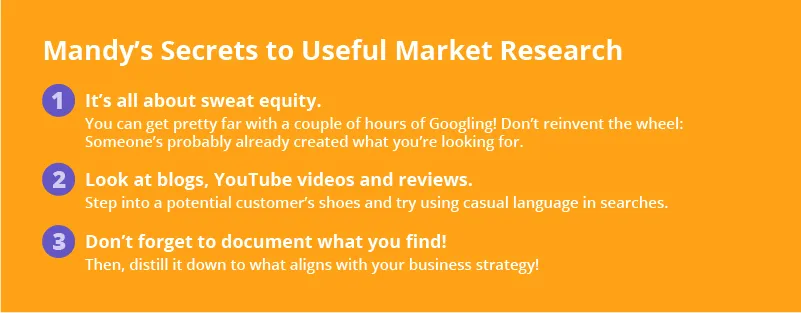Accelo Acquires Forecast, Adding Depth to AI and Capacity Planning Capabilities
Read the Press Release



Once we’re out of school, many of us have a complicated relationship with research. The prospect of having to dig for information can drum up unpleasant memories of college papers and endless pages of citations.
But if you can get past the air of intimidation that surrounds this necessary task, research can morph into a powerful tool that gives you the insights you need to make intelligent business decisions.
Mandy Anger, VP of Product, is our resident research expert at Accelo.
We sat down for a conversation about three common areas you’re likely to want to research as a leader in professional services:
Finally, we discussed the mix of research methods that work for Mandy and her team — and that she recommends all businesses adopt.
Mandy: “I’ll tell you what we do at Accelo. I call my approach ‘the funnel.’
We always start with our internal experts — in Customer Success, in Sales, in Support — and try to understand the top things they’re hearing from clients regularly.
We also spend a lot of time in our user ideas forum, culling through for things that align with our company goals and what we’re trying to accomplish for the quarter. They’re sometimes phrased differently than what we would search for, and our team has to read between the lines to understand what people are saying they want.
Once we’ve learned everything we can from these sources, we survey our existing users and try to figure out if the things we think are important to them really are important. We confirm the problems they’re trying to solve via those survey responses, then narrow it down.
Finally, we set up user calls to dig down into the real problem and some potential solutions. Do they need to be able to access something daily or weekly? How do they use it? We seek to understand their use cases and work patterns.”
"Start with what the company is trying to do, and then go out and understand what your clients need around that central goal."
- Mandy Anger, VP of Product

READ NEXT: 5 Benefits of Participating in a User Research Interview
Mandy: “I highly recommend creating personas.
There are different types of personas for each stage of your relationships with clients. So, a marketing persona would be unique from a sales persona or a product persona.
Your clients also need different things at different stages, and there’s a slightly different story to tell about each type of person at each stage. Conversations become so much simpler under the lens of personas because everyone’s using a shared vernacular.”

Mandy: “Every business should be doing it. The key is to have an identified set of competitors that you’re looking at: a few that are currently in your same stage, a few that represent your next growth stage and a few that are up-and-coming.
A best-case scenario is to have all the people in your organization who have an interest in competitor research form a unit and create a shared repository of current competitor information. Otherwise, you risk duplicating a ton of efforts or focusing on too many audiences at once.
Coming back to personas can help with competitor research as well. With a clear understanding of who our users are and what they need, we can differentiate ourselves and tell some really strong stories. But we can also more easily figure out why people are selecting our competitors in certain use cases.”
COMPETITOR RESEARCH PRO TIP: Revisit the classic and powerful SWOT analysis method.
Mandy: “I think you need both. If you go only with quantitative, you don’t understand the nuance. And if you go only with qualitative, you don’t understand the numbers.
You can start with either quantitative or qualitative. When you don’t know what to prioritize, start with quantitative data gathering. But when you’re doing something less concrete, such as a redesign, you’ll want to ask qualitative questions like ‘Who’s using this?’ and ‘How are they using it?’ to determine the best course of action.
On the product team, we truly work on both types of research at the same time, pretty much all the time.
Our process might go something like this:
We start with analytics, with a hypothesis based on data. For example, when Accelo is looking to redesign specific screens in our platform, we first look at usage numbers for each. This helps us prioritize those with enough daily views to make an update noticeable but leave the most popular ones for later — once we’ve established a process that works.
Then, we go out and collect qualitative stories, assumptions and opinions to support that data. Qualitative research is what lets you know how people will receive a change or response and can impact your timing or methodology.”

What will you do with all the meaningful data you gather using Mandy’s methods? We recommend building a seamless client work experience that your prospects, existing clients and loyal brand evangelists will appreciate. Accelo can help. Schedule a demo to see how.

